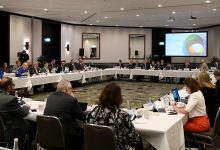State and Territory ministers may again look to sidestep a recalcitrant Morrison government to reduce emissions in the electricity sector, recognising that investment is undeniably shifting to wind, solar and storage.
Speaking at an online forum facilitated by the Smart Energy Council on Wednesday, state and territory energy ministers said that strong progress could still be made in reducing emissions across the electricity sector despite the Morrison government continuing to drag its feet.
When asked why targets for emissions reductions were not already a central consideration in national energy policy decisions, ACT minister Shane Rattenbury pointed the finger at federal energy minister Angus Taylor.
“I can give you a three-word explanation for that. The Federal Government”, Rattenbury said.
“They just do not want to change. They would not include [emissions reductions] in the energy objectives.
“Frankly, the way it works in energy ministers meetings; if the federal government doesn’t want to talk about it, Angus just doesn’t let it on the agenda,” Rattenbury added.
And on the subject of emissions, it should be pointed out that Taylor’s portfolio includes emissions reduction.
Rattenbury added that the switch to a new forum for energy ministers, which sees ministers meet under the ‘national cabinet’ regime following the abolition of the COAG Energy Council, as an opportunity to keep issues moving.
However, the ACT minister said that questions remained around how decisions were made in the new forum, including around the level of control held by federal energy minister Angus Taylor and how issues around confidentially were appropriately balanced with the need for transparency.
“If you look at the last decade, it’s been the states that have shown the leadership in the energy space. So, I think that’s one of the challenges or the risks here, is to see how the Commonwealth leads it.”
ACT climate change minister Shane Rattenbury told the forum that while the states and territories were not able to force the Morrison government to include emissions reductions in planning for the national energy market, state and territory governments still had an ability to facilitate investments in new renewable energy projects.
The state and territory ministers agreed that there are opportunities to ensure the right infrastructure was put in place, including new network investments that align with AEMO’s latest Integrated System Plans, that would allow new wind and solar projects to enter the market.
“Having a debate about having a climate objective or an emissions objective in the National Energy Law is one we can’t win. But the [Integrated System Plan] is one place where we can make progress,” Rattenbury added.
“If we can get things like the transmission infrastructure right, then that sort of takes the ideological debate out of it to some extent, because we can just facilitate the ability of the industry to get on with it.”
“We can actually, frankly, get around the federal government by getting the right infrastructure in place,” Rattenbury added.
As an example of the types of infrastructure that is proving highly attractive to the private sector, Tasmanian energy minister Guy Barnett pointed to the Marinus Link interconnector, between Tasmania and Victoria, which would form part of the wider ‘Battery of the Nation’ project.
“There’ll be a host of investors that would be stepping up to provide support to make it happen. So in that regard, the taxpayers wouldn’t be involved in that respect,” Barnett said.
Western Australian energy minister Bill Johnston highlighted the fact that Western Australia was not bound by the National Energy Law, as the state was separated from the National Electricity Market, which allowed the state to take unilateral measures, but that this also raised its own challenges.
“Fortunately, in Western Australia, we don’t apply the national electricity law so we can act unilaterally. And that’s why we are,” Johnston told the Smart Energy Council forum.
“One of the things that Western Australia would rise at any forum would be the difference between the National Energy Policy and the National Energy Law. National Energy law doesn’t apply in Western Australia, but national energy policy does.”
However, according to Johnston, this came with some challenges in any push towards 100 per cent renewable, as the state could not rely on developments being undertaken in other states, to strengthen Western Australia’s grid, as can occur in the eastern states.
“The Northern Territory and ourselves; we have a completely different set of challenges. I can’t be 100 per cent net renewable. It’s just not possible because I can’t net to somewhere else through an interconnector. So I just have to make sure that the decisions we make, make sure the lights don’t go out,” Johnston added.










